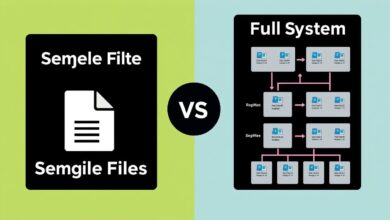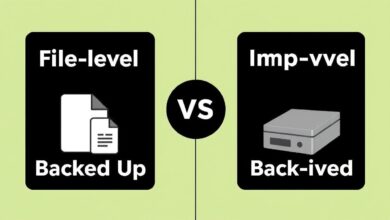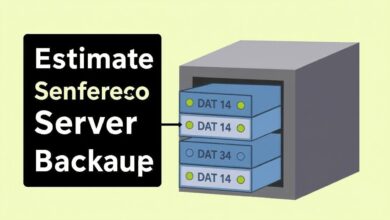Beyond Just Backing Up: Why You MUST Verify Your Server Backups

You’ve set up your server backups. Files are being copied, schedules are running, and the status report says “Success.” Great! You can sleep soundly now, right? Not so fast.
Simply running backup jobs isn’t enough to guarantee your data is safe. The crucial, often-overlooked step is verify server backups. Without verification, you’re essentially stockpiling unknown packages hoping they contain what you need when disaster strikes. What if a file was corrupted during backup? What if the backup media failed? What if the backup software had a silent error?
In the world of servers and critical data, assumptions can be catastrophic. Data loss can cost businesses significant amounts of money and severely damage reputation. This is why moving beyond just backing up to a proactive verification strategy is non-negotiable.
Let’s explore the essential methods to ensure your server backups are not just files on a disk, but truly restorable assets.
Why Verification is Non-Negotiable
A backup file is only useful if you can successfully restore data from it. Verification confirms that the backup process captured the data accurately and, more importantly, that this data can be accessed and utilized when needed. It’s your insurance policy’s test run. Skipping verification is like buying fire insurance but never checking if the policy is valid or if the fire department knows your address.
Regular verification helps identify issues early, such as:
- Corrupted backup files
- Problems with backup media (tapes, disks, cloud storage)
- Configuration errors in backup jobs
- Software glitches
- Incompatibilities with recovery hardware or software
The Gold Standard: Performing Test Restores
Widely regarded as the most reliable verification method, performing actual test restores takes your backup strategy from hopeful to confident. It’s the only way to truly simulate a recovery scenario.
Full Recovery Test
This involves restoring the entire system or a complete dataset to a separate environment. This tests the ability to recover everything, including the operating system, applications, and data. It’s the most comprehensive test but also the most time-consuming and resource-intensive.
Bare Metal Restore (BMR) Simulation
Bare Metal Restore is the process of restoring a system backup to entirely new hardware or a clean operating system installation. Simulating this, often in a virtual machine (VM), is a powerful verification technique. It proves you can rebuild a server from scratch using your backup, testing not just data integrity but also the bootability and configuration recovery.
[Hint: Insert image/video showing a server backup being restored to a virtual machine]File-Level Restore (FLR) Checks
While full restores are great, you should also verify the ability to restore granular data. Can you browse the backup and pull out specific files or folders? This tests the backup’s index and the software’s ability to extract individual items, which is a common recovery scenario.
Testing Different Restore Points
Backups are typically kept for a period, creating multiple restore points. Verification isn’t complete unless you confirm that different recovery points are accessible and usable. Test restoring data from last week’s backup, last month’s, or even older ones based on your retention policy. This ensures your historical data is also safe.
Using Separate Hardware (Especially for Tape Backups)
If you use physical media like tapes, testing restores on a different machine and tape drive than the one used for backup is critical. This helps rule out hardware-specific issues that might prevent recovery on the original device.
Checking Backup File Integrity
Beyond full restore tests, you can perform checks on the backup files themselves.
Leverage Software Features
Most professional backup software includes built-in verification features. These can range from simple checksums (verifying the file hasn’t been altered since creation) to more complex processes that compare the backed-up data against the source or verify the internal structure of the backup file. Database backups often have specific options like CHECKSUM to help ensure the integrity of the database data within the backup.
Manual Inspection (Post-Restore)
After performing a test recovery, it’s essential to manually inspect the restored system or data. Does the application launch? Are the key files present and readable? Is the database accessible and consistent? Automated checks are good, but a manual spot-check confirms usability from a practical perspective.
Monitoring and Alerting: Your First Line of Defense
While not verifying the *content* of the backup directly, monitoring the outcome of your backup jobs is a critical part of the overall strategy. Set up notifications (like email alerts, SNMP traps, or dashboard warnings) to be immediately aware of any reported failures, warnings, or anomalies. A failed backup job means there’s nothing to verify, highlighting the need for prompt attention.
Metadata Checks (Less Direct Verification)
Reviewing metadata like the “Last Updated” time, backup duration, or the backed-up data size can give you an indication that a job *ran* and *completed*. However, this is a weak form of verification. It doesn’t guarantee the data is fully restorable or correct, only that a process occurred and captured *some* data of a certain size. Rely on this only as a preliminary check, not as proof of restorable data.
Integrating Verification into Your Backup Strategy
Verification shouldn’t be an afterthought; it must be a scheduled, regular part of your backup process. The frequency depends on your Recovery Time Objective (RTO) and Recovery Point Objective (RPO), but monthly or quarterly test restores are a common starting point for critical systems. Document your verification process and results. Treat failed verification tests with the same urgency as failed backups.
For beginners setting up their first server, understanding the importance of backups is key (Why Server Backups are Crucial and How Often to Do Them). Adding verification solidifies that foundation.
Conclusion
Backing up your server data is essential, but it’s only half the battle. Verify server backups regularly through test restores and integrity checks is the only way to be truly confident that your data can be recovered when the worst happens. Don’t leave the safety of your critical information to chance; implement a robust backup verification plan today.




